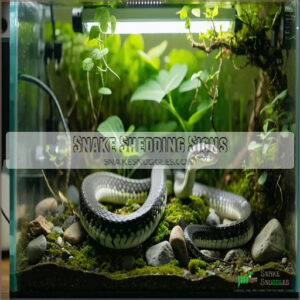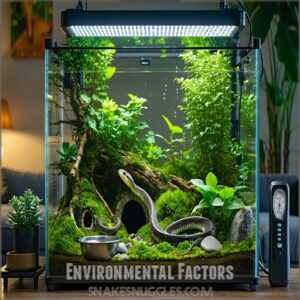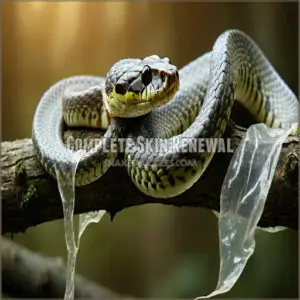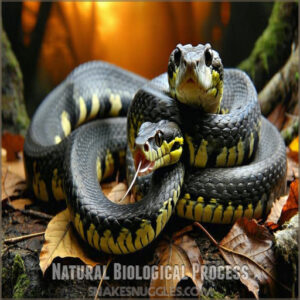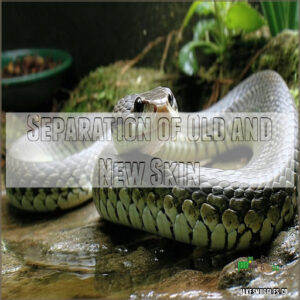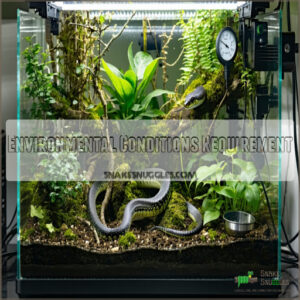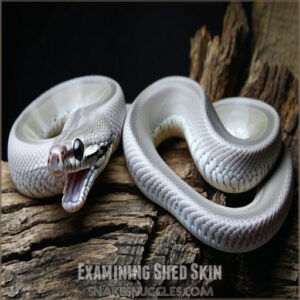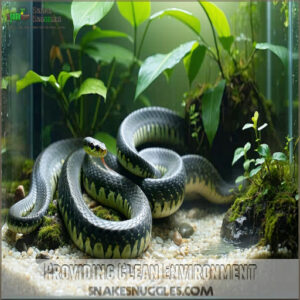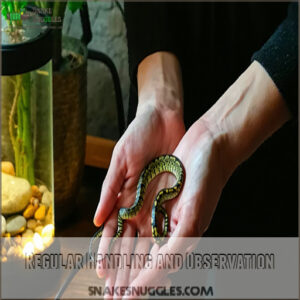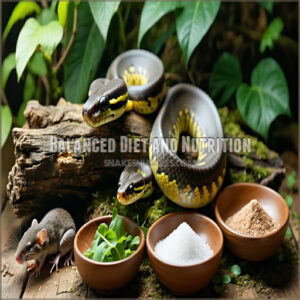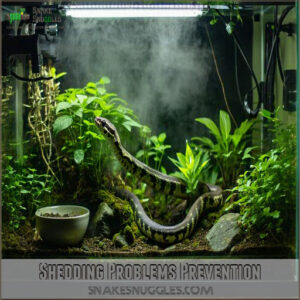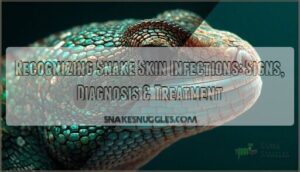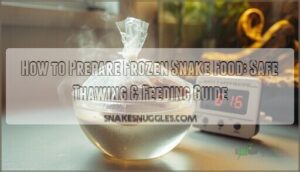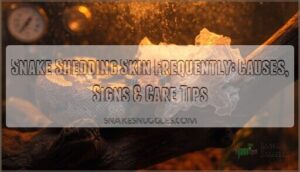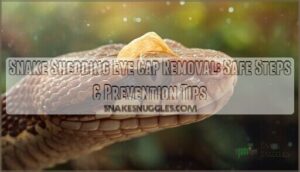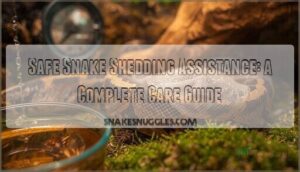This site is supported by our readers. We may earn a commission, at no cost to you, if you purchase through links.
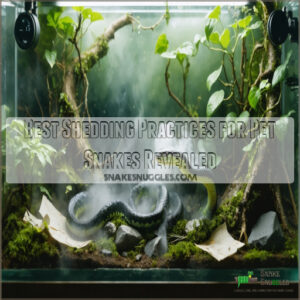
Keep their habitat humid—humidity around 50-70% is a sweet spot—so their skin doesn’t stick like a bad sweater.
You’ll spot signs like cloudy eyes, dull skin, less appetite, and extra wiggly behavior when shedding is near.
Add some rough surfaces or damp paper towels in their tank—it’s like giving them a spa day with exfoliation.
If any old skin or eye caps stick, step in to assist, and remember that regular observation and a cozy, clean home prevent issues before they even start.
Table Of Contents
- Key Takeaways
- Snake Shedding Signs
- Environmental Factors
- Shedding Process
- Post-Shedding Care
- Shedding Problems Prevention
- Frequently Asked Questions (FAQs)
- How can I help my snake shed better?
- Should I soak my snake while shedding?
- Should I peel my snakes shed off?
- Should I leave my ball python alone while shedding?
- How can I identify stress in snakes?
- What signs indicate dehydration in snakes?
- Can shedding frequency vary between snake species?
- How does lighting affect a snake’s shedding?
- Are there breed-specific challenges for snake shedding?
- Conclusion
Key Takeaways
- Keep humidity levels at 50-70% to ensure smooth shedding and prevent stuck skin issues.
- Provide rough surfaces or damp hides to help your snake remove its old skin effectively.
- Monitor their behavior for signs like cloudy eyes, dull skin, and increased activity as shedding approaches.
- Inspect shed skin afterward to check for retained patches, especially around the eyes and tail, and assist only if necessary to ensure smooth shedding.
Snake Shedding Signs
You’ll notice your pet snake is about to shed when its eyes turn cloudy and its skin appears dull.
As you observe your snake’s behavior, you’ll see it become more restless, rub against objects, and even lose its appetite, all indicating that a shed is imminent.
The behaviors mentioned, such as becoming more restless, are key indicators of an impending shed.
Cloudy Eyes Indication
You notice cloudy eyes in your pet snake, a sign of shedding issues.
Potentially leading to eye infection, vision loss, or blindness risk if not addressed, as retained eye caps can cause dysecdysis, a stuck shed, and other shedding problems.
Dull Skin Appearance
You see dull skin on your pet snake, a sign of impending shed.
Check for retained eye caps and skin issues.
Follow Skin Health Tips and Scale Care for Color Enhancement and better Skin Texture, using Shedding Aids to prevent snake shedding problems.
Reduced Appetite
You’ll observe your snake’s reduced appetite before shedding.
- Loss of appetite
- Food aversion
- Nutrient deficiency
Decreased appetite signals shedding problems, like incomplete shedding, so adjust their feeding schedule to stimulate appetite.
Monitoring for snake health issues is necessary during this time, especially to identify snake health issues, incomplete shedding, and adjust their feeding schedule accordingly to prevent nutrient deficiency.
Increased Activity Levels
As your snake prepares to shed, you’ll likely notice increased activity levels, a sign that the shedding process is kicking in.
Monitor their movement patterns, ensuring environmental enrichment to support their exercise and behavioral changes, which can impact shedding frequency and overall health during this critical cycle.
Rubbing Against Objects
You’ll find your pet snake rubbing against objects to reduce friction, aiding in snake shedding.
Selecting the right object with a suitable surface texture can help, almost like a snake massage, to prevent stuck shed and shedding problems in snakes.
Utilizing shedding aids with rough surfaces can also be beneficial in this process.
Environmental Factors
You play a vital role in creating an ideal environment for your pet snake’s shedding process.
By controlling humidity levels, setting up a proper habitat, and maintaining perfect temperature, you’ll be helping your snake shed its skin smoothly and healthily.
This environment is crucial for the snake’s overall health, and by getting it right, you ensure a healthy shedding process.
Humidity Levels Importance
You monitor humidity levels, keeping them between 50-60%.
Key factors include:
- Humidity control
- Moisture levels
- Water bowls
- Spray systems, using a hygrometer to guarantee ideal humidity levels for your pet snake’s humid environment.
Maintaining proper shedding conditions is vital for their health.
Proper Habitat Setup
Setting up a solid snake enclosure isn’t rocket science, but it needs some thought.
Start with the right substrate options for comfort and cleanliness. Add hide boxes for privacy—snakes love their alone time! Keep water sources fresh, maintain proper ventilation systems, and pick lighting choices wisely.
With steady temperature control, you’ll create the perfect humid environment for stress-free shedding. Providing the right snake hide boxes is vital for reducing stress in pet snakes.
| Aspect | Why It Matters | Suggestions |
|---|---|---|
| Substrate | Comfort, cleanliness | Aspen, cypress mulch |
| Hide Boxes | Reduces stress | Provide at least 2 |
| Water Sources | Supports shedding, health | Large bowl, clean daily |
Regular Enclosure Cleaning
A well-kept snake enclosure isn’t just about looks—it’s a shedding lifesaver.
Stick to consistent cleaning schedules, focusing on daily waste removal and swapping out soiled substrate options.
Proper snake enclosure cleanliness promotes a healthy environment.
Use safe disinfecting methods to tackle odors and bacteria.
A tidy habitat minimizes environmental stressors, keeps humidity levels steady, and supports shedding aids like moss.
Good hygiene equals happy scales, which is a result of a well-maintained and tidy habitat.
Maintaining Optimal Temperature
Think of your snake’s habitat like a thermostat battle—you’ve got to nail the right warmth levels.
Create thermal gradients using heat sources, letting your snake choose its comfort zone.
Cooling systems are just as important; too hot, and shedding gets tricky.
Temperature control works hand-in-hand with humidity levels to maintain a humid environment, ensuring smooth skin shedding.
Shedding Process
Shedding is your snake’s way of ditching its old wardrobe for a fresh, vibrant look—it’s a normal and healthy process.
This amazing renewal requires specific conditions, like proper humidity, to go off without a hitch.
Complete Skin Renewal
Your snake’s shedding process is all about complete skin renewal – nature’s way of keeping their scales in top shape.
During this molt, their skin regenerates, shedding old layers as part of renewal cycles.
Think of it as hitting refresh on their wardrobe!
Shedding triggers vary, but healthy molt patterns show your snake’s shedding frequency and overall scale health are right on track, indicating a complete skin renewal, a sign of healthy molt patterns, and overall scale health.
Natural Biological Process
Shedding is a natural biological process fueled by growth patterns and hormone balance.
Your snake’s metabolic rate and cellular renewal work overtime during this cycle.
Here’s what drives the magic:
- Hormones trigger skin regeneration.
- The snake’s body prepares for shedding frequency.
- Cellular activity supports the snake shedding cycle.
- Metabolic processes facilitate smooth phases.
Nature’s renewal system, perfected, is a result of the snake shedding cycle.
Separation of Old and New Skin
Ever wondered how snakes pull off that perfect wardrobe change?
Skin separation happens when the old skin loosens, letting the new skin shine through.
During the shedding cycle, snakes often need a little help avoiding stuck sheds.
Understanding the snake skin shedding process is essential for their health.
| Signs of Separation | Old Skin | New Skin | Shedding Aid |
|---|---|---|---|
| Texture | Dry | Smooth | Humid Environment |
| Appearance | Flaky | Vibrant | Damp Cloth |
| Snake Activity | Rubbing | Stretching | Shedding Box |
| Shedding Completion | Cracks | Intact | Warm Water Soak |
The table outlines key differences and aids for the snake’s skin separation process, including texture, appearance, and activity.
Environmental Conditions Requirement
Creating the perfect environment for your shedding snake is like setting up a spa day.
Balance temperature control and humidity levels to keep their skin healthy.
- Verify proper humidity management with a humid environment (but not soggy).
- Use reliable lighting systems for a consistent day-night cycle.
- Keep substrate clean; poor air circulation invites trouble.
Happy snakes, happy life!
Post-Shedding Care
Once your snake finishes shedding, it’s time to check for leftover skin, especially around the eyes and tail tip.
Keeping their enclosure clean and humidity balanced will help their fresh skin stay healthy and vibrant.
Examining Shed Skin
After the snake shedding process, inspect the shed snake skin closely.
Check shed patterns and scale health—any gaps or breaks might signal stuck shed or retained eye caps.
Smooth skin texture across the molt cycles signals balance, but irregularities hint at possible dermatological issues.
Spot problems early to keep your snake comfortable and avoid big shedding problems snakes face later, ensuring a healthy shedding process and preventing dermatological issues.
Providing Clean Environment
A clean enclosure is key to proper snake shedding.
Toss out old substrate options and replace them with fresh, dry material.
Wash decorations and sanitize food and water dishes to keep things spotless.
Fresh water is non-negotiable, and maintaining humidity levels guarantees a stress-free environment.
Hygiene practices like this create a humid environment that promotes healthy shedding and prevents issues.
Regular use of proper snake cleaning supplies is essential for maintaining a clean and healthy environment.
Regular Handling and Observation
After tidying up their space, it’s time to use your observation skills and gentle touch.
Regular handling helps you spot changes in snake behavior and avoid shedding problems down the road.
Keep sessions short to guarantee a stress-free environment.
Watch for:
- Excessive hiding or rubbing.
- Signs of retained skin.
- Changes in temperament.
- Trouble completing sheds, which can be a sign of underlying issues that need attention for a healthy shedding process.
Balanced Diet and Nutrition
A snake’s shedding success starts with proper nutrition.
Focus on nutrient balance and food variety—like offering rodents or reptile-safe treats.
Stick to regular meal scheduling and consider vitamin supplements for an extra boost.
Hydration matters too—always provide fresh water.
Want a cheat sheet? Here you go:
| Key Focus | Practical Tip |
|---|---|
| Nutrient Balance | Varied rodent sizes weekly |
| Food Variety | Rotate meal types |
| Meal Scheduling | Feed every 1-2 weeks |
| Vitamin Supplements | Add calcium powder |
| Hydration | Clean water daily |
Shedding Problems Prevention
Keeping your snake healthy during shedding starts with proper humidity, nutrition, and reducing stress. By addressing these factors early, you’ll prevent stuck sheds and keep your pet comfortable.
Improper Humidity Levels
Humidity control is essential for shedding smoothness.
Without balanced moisture levels, snakes might struggle, leaving patches behind.
Snakes shed their skin for growth and renewal, a process often affected by problematic shedding humidity.
Use a reliable hygrometer to monitor snake humidity levels, aiming for 50-70%.
Add water bowls or spray systems to tweak humidity, but don’t overdo it—nobody likes a swamp!
Proper humidity levels are your shedding secret weapon, so keep an eye on it!
Poor Nutrition Effects
When food quality takes a nosedive, so does your snake’s shedding success.
Improper diets lead to malnutrition signs like dull skin and stubborn old scales.
Watch for:
- Dietary deficits causing poor nutrient absorption.
- Vitamin deficiencies triggering slower growth.
- Dehydration making skin less elastic.
- Shedding issues linked to low energy intake.
Fix it fast—your snake deserves balanced nutrition!
Illness and Stress Impact
When shedding problems pop up, underlying health issues like snake diseases or infections might be to blame.
Stress signals, like excessive hiding or erratic behavior, can worsen things, increasing health risks.
A stress-free environment helps, but don’t overlook dehydration or infection control.
If shedding problems persist, a vet visit guarantees proper veterinary care and keeps your snake shedding smoothly and safely.
Regular checks for snake shedding issues can help identify potential health problems early on, ensuring a safe and smooth shedding process with proper veterinary care.
Retained Skin Issues
Retained skin isn’t just cosmetic—it can lead to serious scale issues or even skin infections.
Look out for retained patches or stubborn spots like retained eye caps.
Stuck shed often happens due to retention causes like low humidity, use shedding aids like warm baths or moist towels to help.
Address snake stuck shed quickly to avoid incomplete shedding complications.
Incomplete Sheds Solutions
Struggling with incomplete shedding? Stuck sheds, including retained eye caps, can make your snake uncomfortable.
Try a Skin Soak: warm water baths a few times a day work wonders.
Need extra snake shedding help? Consider helpful snake shedding aid products.
Wrap them in a warm, damp towel for gentle Scale Repair. A Humidity Boost with a special hide prevents shedding difficulty and future issues.
Frequently Asked Questions (FAQs)
How can I help my snake shed better?
Think of your snake’s skin like a snug sweater — it needs the perfect fit.
Keep humidity up, offer rough surfaces to rub on, and soak them gently if needed.
A happy shed equals a happy snake!
Should I soak my snake while shedding?
A lukewarm soak can work wonders for helping your snake shed smoothly.
Just keep it brief—10-15 minutes tops—and don’t overdo it.
Use shallow water so your snake feels safe, not stressed.
Should I peel my snakes shed off?
Don’t be tempted to “help” by peeling your snake’s shed—it’s like pulling off a bandaid that isn’t ready.
Let them handle it naturally, but offer a humid hide or gentle soak if needed.
Should I leave my ball python alone while shedding?
Give your ball python space while it sheds—it’s like their version of a spa day.
Handling can stress them out.
Just make sure the humidity’s perfect, and let them relax and do their thing.
How can I identify stress in snakes?
You’ll know your snake’s stressed if it hisses more, refuses food, or hides constantly.
Rapid movements, biting attempts, or wriggling while handled are also red flags.
Pay attention—your snake’s body language speaks volumes, and recognizing these signs can help you identify if your snake is experiencing stress.
What signs indicate dehydration in snakes?
Dry, wrinkled skin, sunken eyes, and lack of urination scream dehydration in your snake.
If its shed peels off in bits instead of one smooth piece, it’s a telltale sign hydration needs attention—pronto!
Can shedding frequency vary between snake species?
Shedding frequency definitely varies between snake species.
Some, like corn snakes, shed every few weeks when growing, while others, like boas, take their time.
Factors like age, size, and health also change the schedule.
How does lighting affect a snake’s shedding?
Think of lighting as your snake’s internal clock.
Without consistent cycles of light and dark, their shedding process can stumble.
Mimic natural daylight patterns to keep their skin cycles smooth—no one loves patchy, frustrating sheds, and maintaining a consistent lighting schedule is crucial for a healthy shedding process is not needed, instead:
Mimic natural daylight patterns to keep their skin cycles smooth—no one loves patchy, frustrating sheds.
Are there breed-specific challenges for snake shedding?
Some snake breeds struggle more with shedding, like ball pythons and rainbow boas.
They often face humidity issues, leading to stuck shed.
Keep their habitat moist, and you’ll avoid those awkward “patchy skin” moments!
Conclusion
Helping your snake shed properly isn’t just about keeping them comfy—it’s essential for their health.
When you nail the best shedding practices for pet snakes, like maintaining humidity and providing rough surfaces, you’re setting them up for smooth sheds every time.
Keep an eye on their behavior, check for stuck skin, and make their habitat feel like home.
A little effort on your part means fewer problems and a healthier, happier snake in the long run.
- https://petsnorms.com/snake-shedding-process/
- https://www.petcovergroup.com/uk/shedding-in-snakes-dos-and-donts/
- https://vetexplainspets.com/how-to-help-a-snake-with-stuck-shed/
- https://www.wikihow.com/Care-for-a-Shedding-Snake
- https://ballpythonbreeder.co.uk/ball-python-care-sheet/ball-python-humidity-water-shedding/ball-python-shedding-and-humidity/

